The recent data on ancient DNA from Iberia published by Olalde et al. (2019) was interesting for many different reasons, but I still have the impression that the authors – and consequently many readers – focused on not-so-relevant information about more recent population movements, or even highlighted the least interesting details related to historical events.
I have already written about the relevance of its findings for the Indo-European question in an initial assessment, then in a more detailed post about its consequences, then about the arrival of Celtic languages with hg. R1b-M167, and later in combination with the latest hydrotoponymic research.
This post is thus a summary of its findings with the help of natural neighbour interpolation maps of the reported Germany_Beaker and France_Beaker ancestry for individual samples. Even though maps are not necessary, visualizing geographically the available data facilitates a direct comprehension of the most relevant information. What I considered key points of the paper are highlighted in bold, and enumerated.
NOTE. To get “more natural” maps, extrapolation for the whole Iberian Peninsula is obtained by interpolation through the use of external data from the British Isles, Central Europe, and Africa. This is obviously not ideal, but – lacking data from the corners of the Iberian Peninsula – this method gives a homogeneous look to all maps. Only data in direct line between labelled samples in each map is truly interpolated for the Iberian Peninsula, while the rest would work e.g. for a wider (and more simplistic) map of European Bronze Age ancestry components.
Chalcolithic
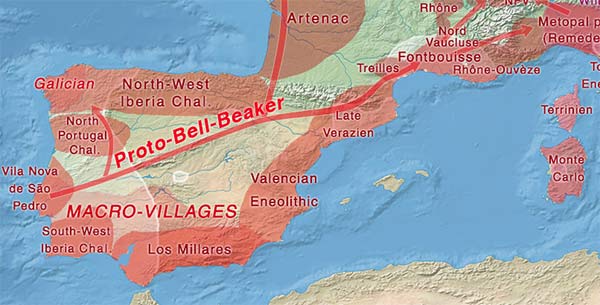
The Proto-Beaker package may or may not have expanded into Central Europe with typical Iberia_Chalcolithic ancestry. A priori, it seems a rather cultural diffusion of traits stemming from west Iberia roughly ca. 2800 BC.

The situation during the Chalcolithic is only relevant for the Indo-European question insofar as it shows a homogeneous Iberia_Chalcolithic-like ancestry with typical Y-chromosome (and mtDNA) haplogroups of the Iberian Neolithic dominating over the whole Peninsula until about 2500 BC. This might represent an original Basque-Iberian community.
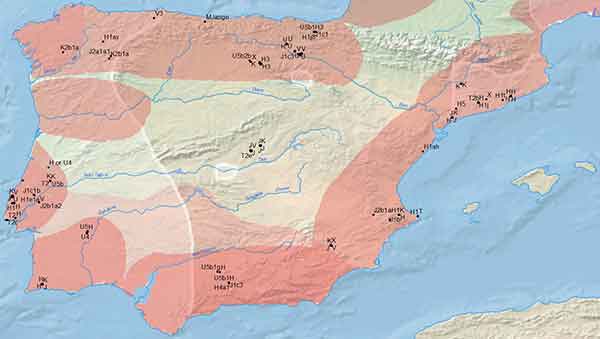
Bell Beaker period
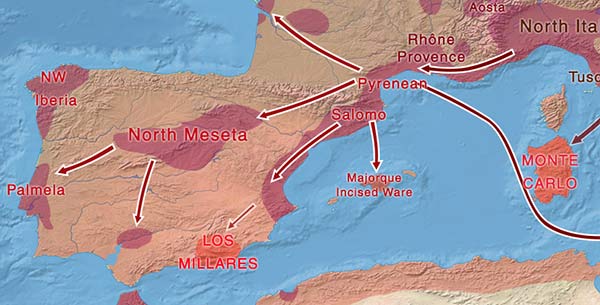
The expansion of the Bell Beaker folk brought about a cultural and genetic change in all Europe, to the point where it has been rightfully considered by Mallory (2013) – the last one among many others before him – the vector of expansion of North-West Indo-European languages. Olalde et al. (2019) proved two main points in this regard, which were already hinted in Olalde et al. (2018):
(1) East Bell Beakers brought hg. R1b-L23 and Yamnaya ancestry to Iberia, ergo the Bell Beaker phenomenon was not a (mere) local development in Iberia, but involved the expansion of peoples tracing their ancestry to the Yamnaya culture who eventually replaced a great part of the local population.

(2) Classical Bell Beakers have their closest source population in Germany Beakers, and they reject an origin close to Rhine Beakers (i.e. Beakers from the British Isles, the Netherlands, or northern France), ergo the Single Grave culture was not the origin of the Bell Beaker culture, either (see here).


Early Bronze Age

Interestingly, the European Early Bronze Age in Iberia is still a period of adjustments before reaching the final equilibrium. Unlike the situation in the British Isles, where Bell Beakers brought about a swift population replacement, Iberia shows – like the Nordic Late Neolithic period – centuries of genomic balancing between Indo-European- and non-Indo-European-speaking peoples, as could be suggested by hydrotoponymic research alone.
(3) Palaeo-Indo-European-speaking Old Europeans occupied first the whole Iberian Peninsula, before the potential expansion of one or more non-Indo-European-speaking groups, which confirms the known relative chronology of hydrotoponymic layers of Iberia.

This balancing is seen in terms of Germany_Beaker vs. Iberia_Chalcolithic ancestry, but also in terms of Y-chromosome haplogroups, with the most interesting late developments happening in southern Iberia, around the territory where El Argar eventually emerged in radical opposition to the Bell Beaker culture.
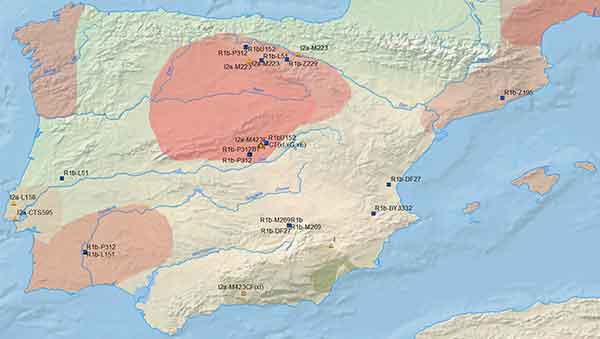
(4) Bell Beakers and descendants expanded under male-driven migrations, proper of the Indo-European patrilineal tradition, seen in Yamnaya and even earlier in Khvalynsk:
We obtained lower proportions of ancestry related to Germany_Beaker on the X-chromosome than on the autosomes (Table S14), although the Z-score for the differences between the estimates is 2.64, likely due to the large standard error associated to the mixture proportions in the X-chromosome.

Regarding the PCA, Iberia Bronze Age samples occupy an intermediate cluster between Iberia Chalcolithic and Bell Beakers of steppe ancestry, with Yamnaya-rich samples from the north (Asturias, Burgos) representing the likely source Old European population whose languages survived well into the Roman Iron Age:
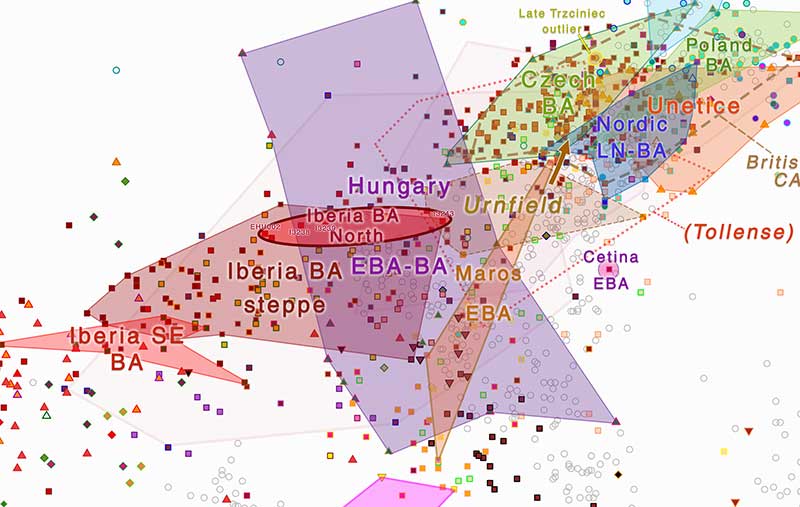
Middle Bronze Age
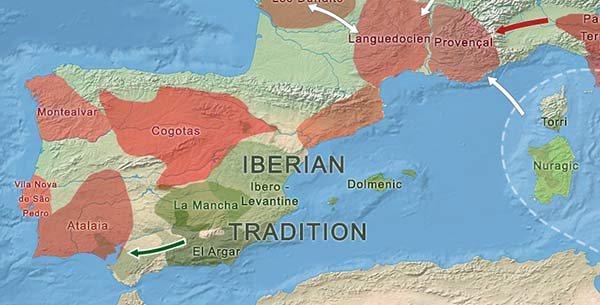
During the Middle Bronze Age, the equilibrium reached earlier is reversed, with a (likely non-Indo-European-speaking) Argaric sphere of influence expanding to the west and north featuring Iberia Chalcolithic and lesser amount of Germany_Beaker ancestry, present now in the whole Peninsula, although in varying degrees.

All Iberian groups were probably already under a bottleneck of R1b-DF27 lineages, although it is likely that specific subclades differed among regions:
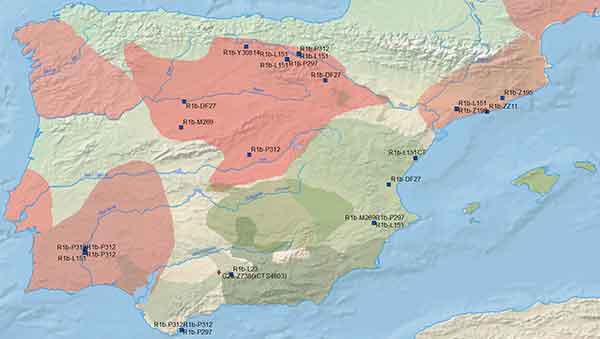
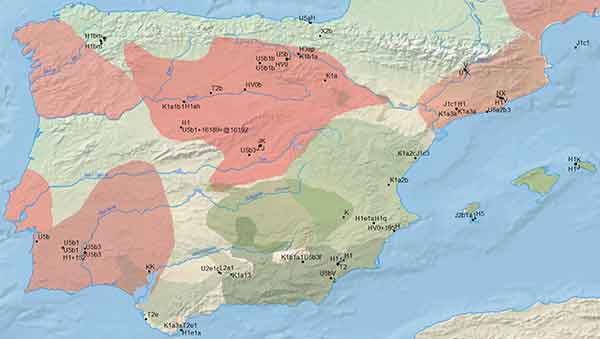
Late Bronze Age
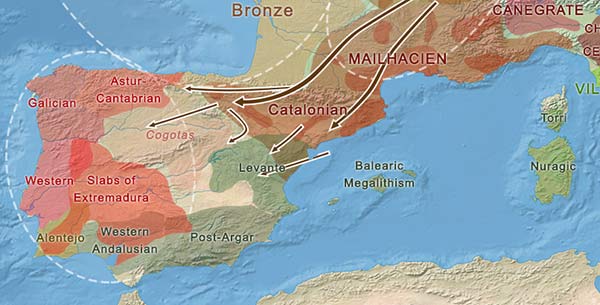
The Late Bronze Age represents the arrival of the Urnfield culture, which probably expanded with Celtic-speaking peoples. A Late Bronze Age transect before their genetic impact still shows a prevalent Germany_Beaker-like Steppe ancestry, probably peaking in north/west Iberia:

(5) Galaico-Lusitanians were descendants of Iberian Beakers of Germany_Beaker ancestry and hg. R1b-M269. Autosomal data of samples I7688 and I7687, of the Final Bronze (end of the reported 1200-700 BC period for the samples), from Gruta do Medronhal (Arrifana, Coimbra, Portugal) confirms this.
In the 1940s, human bones, metallic artifacts (n=37) and non-human bones were discovered in the natural cave of Medronhal (Arrifana, Coimbra). All these findings are currently housed in the Department of Life Sciences of the University of Coimbra and are analyzed by a multidisciplinary team. The artifacts suggest a date at the beginning of the 1st millennium BC, which is confirmed by radiocarbon date of a human fibula: 890–780 cal BCE (2650±40 BP, Beta–223996). This natural cave has several rooms and corridors with two entrances. No information is available about the context of the human remains. Nowadays these remains are housed mixed and correspond to a minimum number of 11 individuals, 5 adults and 6 non-adults.
In particular, sample I7687 shows hg. R1b-M269, with no available quality SNPs, positive or negative, under it (see full report). They represent thus another strong support of the North-West Indo-European expansion with Bell Beakers.
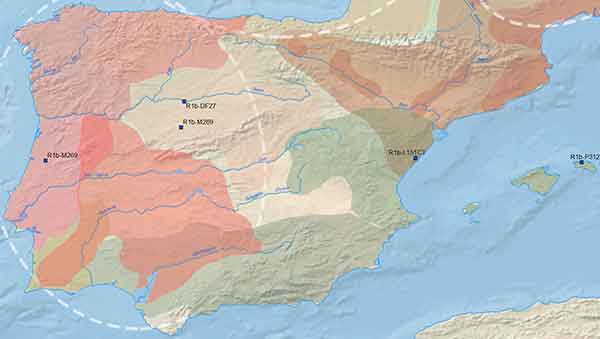
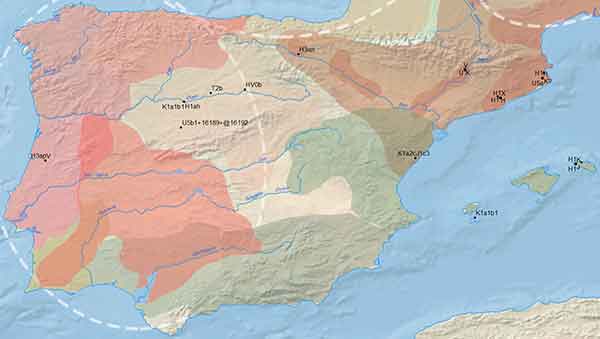
NOTE. To understand how the region around Coimbra was (Proto-)Lusitanian – and not just Old European in general – until the expansion of the Turduli Oppidani, see any recent paper on Bronze Age expansion of warrior stelae, hydrotoponymy, anthroponymy, or theonymy (see e.g. about Spear-vocabulary).
Iron Age
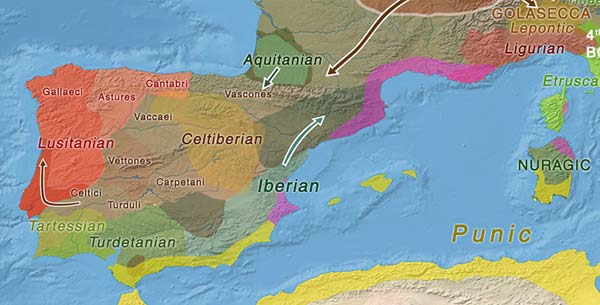
In a complex period of multiple population movements and language replacements, the temporal transect in Olalde et al. (2019) offers nevertheless relevant clues for the Pre-Roman Iron Age:
(6) The expansion of Celtic languages was associated with the spread of France_Beaker-like ancestry, most likely already with the LBA Urnfield culture, since a Tartessian and a Pre-Iberian samples (both dated ca. 700-500 BC) already show this admixture, in regions which some centuries earlier did not show it. Similarly, a BA sample from Álava ca. 910–840 BC doesn’t show it, and later Celtiberian samples from the same area (ca. 4th c. BC and later) show it, depicting a likely north-east to west/south-west routes of expansion of Celts.

(7) The distribution of Germany_Beaker ancestry peaked, by the Iron Age, among Old Europeans from west Iberia, including Galaico-Lusitanians and probably also Astures and Cantabri, in line with what was expected before genetic research:

A probably more precise picture of the Final Bronze – Early Iron Age transition is obtained by including the Final Bronze samples I2469 from El Sotillo, Álava (ca. 910-875 BC) as Celtic ancestry buffer to the west, and the sample I3315 from Menorca (ca. 904-861 BC), lacking more recent ones from intermediate regions:

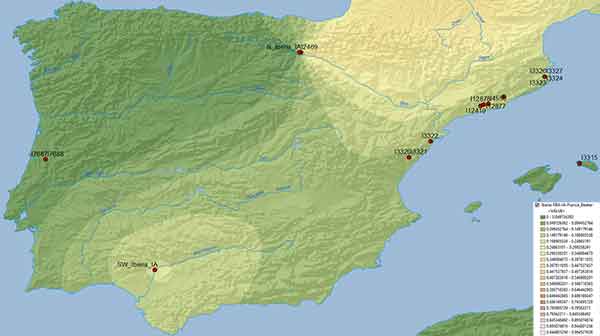
In terms of Y-DNA and mtDNA haplogroups, the situation is difficult to evaluate without more samples and more reported subclades:
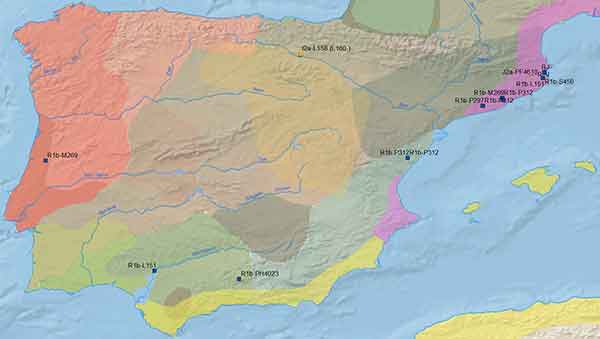
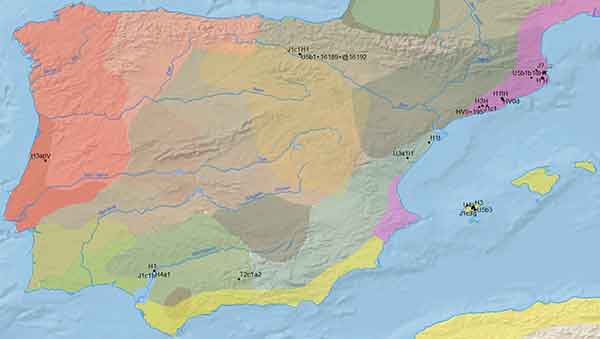
In the PCA, Proto-Lusitanian samples occupy an intermediate cluster between Iberian Bronze Age and Bronze Age North (see above), including the Final Bronze sample from Álava, while Celtic-speaking peoples (including Pre-Iberians and Iberians of Celtic descent from north-east Iberia) show a similar position – albeit evidently unrelated – due to their more recent admixture between Iberian Bronze Age and Urnfield/Hallstatt from Central Europe:
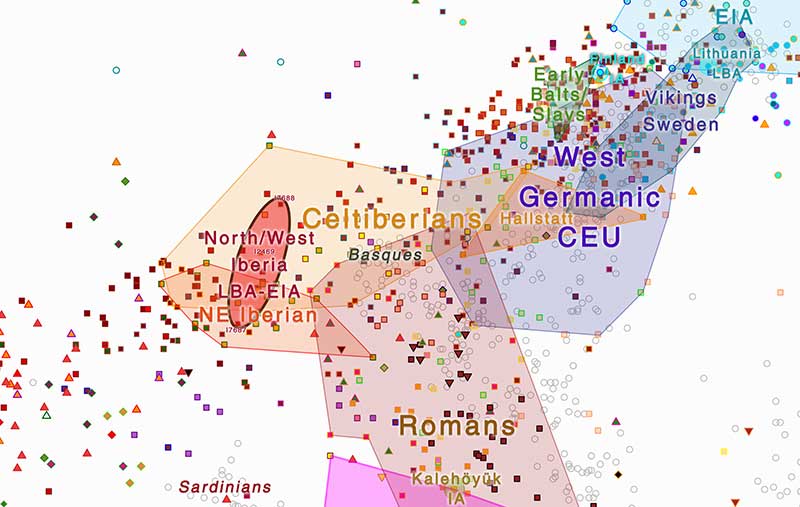
(8) Iberian-speaking peoples in north-east Iberia represent a recent expansion of the language from the south, possibly accompanied by an increase in Iberia_Chalcolithic/Germany_Beaker admixture from east/south-east Iberia.
(9) Modern Basques represent a recent isolation + Y-DNA bottlenecks after the Roman Iron Age population movements, probably from Aquitanians migrating south of the Pyrenees, admixing with local peoples, and later becoming isolated during the Early Middle Ages and thereafter:
[Modern Basques] overlap genetically with Iron Age populations showing substantial levels of Steppe ancestry.
Assuming that France_Beaker ancestry is associated with the Urnfield culture (spreading with Celtic-speaking peoples), Vasconic speakers were possibly represented by some population – most likely from France – whose ancestry is close to Rhine Beakers (see here).
Alternatively, a Vasconic language could have survived in some France/Iberia_Chalcolithic-like population that got isolated north of the Pyrenees close to the Atlantic Façade during the Bronze Age, and who later admixed with Celtic-speaking peoples south of the Pyrenees, such as the Vascones, to the point where their true ancestry got diluted.
In any case, the clear Celtic Steppe-like admixture of modern Basques supports for the time being their recent arrival to Aquitaine before the proto-historical period, which is in line with hydrotoponymic research.
Conclusion
The most interesting aspects to discuss after the publication of Olalde et al. (2019) would have been thus the nature of controversial Palaeohispanic peoples for which there is not much linguistic data, such as:
- the Astures and the Cantabri, usually considered Pre-Celtic Indo-European (see here);
- the Vaccaei, usually considered Celtic;
- the Vettones, traditionally viewed as sharing the same language as Lusitanians due to their apparent shared hydrotoponymic, anthroponymic, and/or theonymic layers, but today mostly viewed as having undergone Celticization and helped the westward expansion of Celtic languages (and archaeologically clearly divided from Old European hostile neighbours to the west by their characteristic verracos);
- the Pellendones or the Carpetani, who were once considered Pre-Celtic Indo-Europeans, too;
- the nature of Tartessian as Indo-European, or maybe even as “Celtic”, as defended by Koch;
- or the potential remote connection of Basque and Iberian languages in a common trunk featuring Iberian/France_Chalcolithic ancestry (also including Palaeo-Sardo).

Despite these interesting questions still open for discussion, the paper remarked something already known for a long time: that modern Basques had steppe ancestry and Y-DNA proper of the Yamnaya 5,000 years ago, and that Bell Beakers had brought this steppe ancestry and R1b-P312 lineages to Iberia. This common Basque-centric interpretation of Iberian prehistory is the consequence of a 19th-century tradition of obsessively imagining Vasconic-speaking peoples in their medieval territories extrapolated to Cro-Magnons and Atapuerca (no, really), inhabiting undisturbed for millennia a large territory encompassing the whole Iberia and France, “reduced” or “broken” only with the arrival of Celts just before the Roman conquests. A recursive idea of “linguistic autochthony” and “genetic purity” of the peoples of Iberia that has never had any scientific basis.
Similarly, this paper offered the Nth proof already in population genomics that traditional nativist claims for the origin of the Bell Beaker folk in Western Europe were wrong, both southern (nativist Iberian origin) and northern European (nativist Lower Rhine origin). Both options could be easily rejected with phylogeography since 2015, they were then rejected in Olalde et al. and Mathieson et al (2017), then again with the update of many samples in Olalde et al. (2018) and Mathieson et al (2018), and it has most clearly been rejected recently with data from Wang et al. (2018) and its Yamnaya Hungary samples. Findings from Olalde et al. (2019) are just another nail to coffins that should have been well buried by now.
Even David Anthony didn’t have any doubt in his latest model (2017) about the Carpathian Basin origin of North-West Indo-Europeans (see here), and his latest update to the Proto-Indo-European homeland question (2019) shows that he is convinced now about R1b bottlenecks and proper Pre-Yamnaya ancestry stemming from a time well before the Bell Beaker expansion. This won’t be the last setback to supporters of zombie theories: like the hypotheses of an Anatolian, Armenian, or OIT origin of the PIE homeland, other mythical ideas are so entrenched in nationalist and/or nativist tradition that many supporters will no doubt prefer them to die hard, under the most numerous and shameful rejections of endlessly remade reactionary models.
Related
- European hydrotoponymy (II): Basques and Iberians after Lusitanians and “Ligurians”
- European hydrotoponymy (I): Old European substrate and its relative chronology
- Aquitanians and Iberians of haplogroup R1b are exactly like Indo-Iranians and Balto-Slavs of haplogroup R1a
- Iberia: East Bell Beakers spread Indo-European languages; Celts expanded later
- Iberia in the Copper and Early Bronze Age: Cultural, demographic, and environmental analysis
- Haplogroup R1b-M167/SRY2627 linked to Celts expanding with the Urnfield culture
- Analysis of R1b-DF27 haplogroups in modern populations adds new information that contrasts with ‘steppe admixture’ results
- On Latin, Turkic, and Celtic – likely stories of mixed societies and little genetic impact
- Patterns of genetic differentiation and the footprints of historical migrations in the Iberian Peninsula
- First Iberian R1b-DF27 sample, probably from incoming East Bell Beakers
- Ancient Sardinia hints at Mesolithic spread of R1b-V88, and Western EEF-related expansion of Vasconic
- Arrival of steppe ancestry with R1b-P312 in the Mediterranean: Balearic Islands, Sicily, and Iron Age Sardinia
- Modern Sardinians show elevated Neolithic farmer ancestry shared with Basques
- Iberian prehistoric migrations in Genomics from Neolithic, Chalcolithic, and Bronze Age
